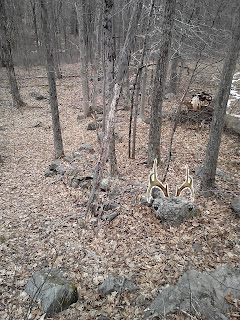Native American Heritage Month, November 2018 - "a time to celebrate rich and diverse cultures, traditions, and histories and to acknowledge the important contributions of Native people...an opportune time to educate the general public about tribes, to raise a general awareness..."
Or at least, were.
It was just a little over two years ago that a Ceremonial Stone Landscape was bulldozed at Standing Rock in North Dakota - and I'm not sure how many people are aware of that either.
I'm pretty sure most people in my town and many towns around here would tell me that it is actually an unremarkable and quite common feature, the iconic farmer's fence or stone wall, the smaller stones kept in place by the boulder at the gateway, just like one on their property, at their home or grandpa's farm.
Or perhaps this one, about five miles north of the one on the Trail to the Roaring Waters:
There is a National Park Service training video that illustrates a Snake Stone Row or Serpent Effigy: “This is a serpent effigy - and the serpent effigies are quite often in dispute because the presumption is that they are stone walls. Most often, they are too low to pen anything in, but we identify them by other means. Usually they do have a head, such as the one you see here..."
- Doug Harris
The complete text and video can be seen here at the National Park Service YouTube site:
Ceremonial Stone Landscapes of New England and Developing Best Practices to Assess Submerged Paleocultural Landscapes
Doug Harris
Narragansett Tribe
Back to the trail, that flat topped triangular boulder, the shape of the rattlesnake the Uktena is modeled after, imagining it as a Big Snake head, a body behind,
imagining eyes ...
I would further qualify the “stone wall” as an Uktena Qusukqaniyutôk because the head is bent at an angle from the “body” of the “wall” or Qusukqaniyutôk ~ ‘stone row, enclosure’ (Harris and Robinson, 2015:140)
Anthropologist James Mooney:
"Those who know say the Uktena is a great snake, as large around as a tree trunk, with horns on its head, and a bright blazing crest like a diamond on its forehead, and scales glowing like sparks of fire. It has rings or spots of color along its whole length, and can not be wounded except by shooting in the seventh spot from the head, because under this spot are its heart and its life. The blazing diamond is called Ulun'suti -- "Transparent" -- and he who can win it may become the greatest wonder worker of the tribe..."
"According to Mooney (1900:458-459), the name Uktena is derived from akta, or eye, and implies being a “strong looker,” as everything is visible to it (i.e., it can see thoughts). From the same root is derived akta’tĭ, “to see into closely” which is also the Cherokee word for a magnifying lens and telescope. So the name Uktena implies that it sees thoughts and it does so in an accurate way; knowledge that comes in useful to predict enemy tactics (Jannie Loubser - E-mail communication July 21, 2015). " - Uktena "strong-looker"
Some images of the above, updated in 2021:
The Uktena knows your intentions, as you enter the place he guards with his encircling body. The Uktena can help control wildfires set by lightening from the Thunderbird's eyes. Stone Uktena can act as fuel breaks for purposely set controlled Indigenous fires:
Clockwise around the enclosure:
Zigzag Rows of Stones border riparian zones:
More Serpent Gateways


























No comments:
Post a Comment